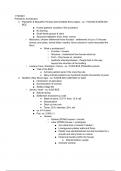1/19/2023
Prehistoric Architecture
● Paleolithic & Mesolithic Periods (Old & Middle Stone Ages) - ca. +100,000-9,000/8,000
BCE
■ Hunter-gatherer societies (“first societies”)
■ No farming
■ Small family groups & clans
■ Seasonal habitation (huts, tents, caves)
○ Mezhyrich, Ukraine (Mammoth-bone houses) - settlements of up to 10 houses
(bones, pine poles, animal hides, hearths, floors colored w/ ochre-decorated the
floor)
● What is architecture?
○ Function - houses
○ Structure - Understood how houses stood up
○ Form - Dog house vs. mansion
○ Aesthetic intent/symbolism - People built in this way
beyond the structure of the building
○ Lascaux Cave, Dordogne, France - ca. 15,000 BCE (Paleolithic period)
■ “Hall of the Bulls”
● Animals painted weren’t the ones they ate
● Many animals painted over hundreds (maybe thousands) of years
● Neolithic (New Stone Age) - ca. 9,000/8,000-3,000 BCE (or later)
■ Introduction of agriculture
■ Domestication of animals
■ Settled village life
○ Jericho, Israel - ca. 8,000 BCE
■ Natural spring
■ Settlement enclosed by a wall
● Made of stone, 5-27 ft. thick, 13 ft. tall
● Demarcation!
● Ditch cut into rock
● Tower: 28 ft. diameter, 26 ft. tall
■ ca. 6-10 acres
■ Pop. ca. 2,000 (+)
● Houses:
○ Earliest (PPNA) houses = circular
○ Later (PPNB) houses = rectangular
■ Sun-dried brick (“mubrick”/”adobe”)
■ Lime/gypsum-plaster walls and floors
■ Plaster was painted/stained red and burnished to a
smooth and shiny finish w/ a stone
■ Intramural burials (within the house)
● Infants/children usually
■ Ancestor worship
, ● Remove skull and decorate it
■ Monumental architecture (above and beyond, material meant to be big,
impressive, meant to last) - House & Tower
○ Catal Huyuk, Turkey - ca. 7,500-5,700 BCE
■ Sun-dried mudbrick (adobe) walls
■ Single story houses w/ two rooms
■ No doorways, entrance through roof
■ Walls coated w/ plaster & painted
● Hasan Dag
● “Map” depicting town & volcanic eruption?
■ Bull skulls coated w/ plaster
■ Female figures representing fertility?
○ Gobekli Tepe (Southeast Turkey) - ca. 9,100-8,100 BCE
■ Layer III (9,000-8,100 BCE)
● Circular rubble enclosures
● T-shaped, limestone pillars
● Benches
○ Investment of time, energy, & resources by a community to
create large-scale (monumental) architecture
● Sculpture carved in relief
,1/24/2023
Prehistoric Architecture Ctn.
● Neolithic (New Stone Age) - ca. 9,000/8,000-3,000 BCE (or later)
○ Newgrange, Ireland - ca. 3,100 BCE
■ “Passage Grave”
● Megalithic architecture
○ Transom, post & lintel doorway, corbeling, and decoration
● Investment of resources/effort
● Monumentality
● Architectural sophistication
● Special orientation
● Symbolism
○ Stonehenge, England - ca. 3,000/2,900-1,500/1,400 BCE
■ Timeline
● 3,000 BCE
○ Circular mound and ditch
○ 56 “Aubrey” Holes
○ Bluestones?
○ Cremation burials?
● 2,800 BCE
○ Timber posts
○ Cremation burials
● 2,500 BCE
○ “Blue Stones” from Wales (150 mi)
○ Station Stones?
○ Altar Stone?
○ Heelstone?
● 2,300 BCE
○ Sarsen stone circle
○ Trilithon “horseshoe”
○ Station Stone rectangle
● 2,100-1,500 BCE
○ Bluestones repositioned within Sarsen Circle
■ Materials, transport, & construction techniques
● Post and lintel construction = structural load in COMPRESSION
● Blocks have been dressed, made smooth (pounding & abrading
with harder stones)
● The lintels were curved to follow the curve of the horseshoe or
outer circle
● The uprights taper from bottom to top
○ “Trilithon” = freestanding, 3 stone feature of the Sarsen
horseshoe
● Construction techniques:
, ○ The uprights (posts) have a tenon in their top surface,
while the lintels have a mortise = “mortise & tenon” (“stub
& tenon”)
■ The horizontal elements (lintels) have “tongue &
groove” joints to lock ends together
■ These techniques are more appropriate for
woodworking
● Functions as a ceremonial center
○ Aligns with:
■ Summer solstice sunrise
■ Winter solstice sunset
○ Possible alignments:
■ Equinox sunrise & sunset
■ Equinox moonrise & moonset




